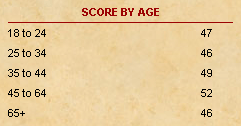NOBODY KNOWS ANYTHING….Via Tyler Cowen, I see that the Intercollegiate Studies Institute has released the results of their annual test on civics and history. The outcomes, as usual, are supposedly abominable: fewer than a third of the 2,500 randomly selected test takers managed to score higher than 60%.
Now, you can decide for yourself how hard the test is and whether a score below 60% is really that bad. (The test is here.) I managed to get all the questions right, but still, there were a fair number that were pretty far from obvious for most people. Is it really that big a deal, for example, that most Americans don’t know that Socrates, Plato, Aristotle, and Aquinas would concur that certain permanent moral and political truths are accessible to human reason? Especially when the question and the five possible answers are being read to them over the phone?
Like I said, you can decide for yourself. But I just want to highlight one particular result: the average score by age group. As regular readers know, one of my pet peeves is the endless number of tests given to high school students and then trumpeted as evidence that kids today are abysmally ignorant. The standard headline is something like “80% of high school seniors can’t find France on a map,” but what I always wonder is: how many adults can find France on a map? Unfortunately, they never tell us that.

But ISI does. And the results are pretty simple: everyone is stupid. ISI themselves spin this as “Baby Boomers Do Best,” but speaking ex cathedra for my generation, I really don’t think that 52% vs. 47% (an average difference of less than two correct answers) says much about the awesomeness of boomer cultural literacy. Basically, the kids didn’t do very well on ISI’s test, but neither did the adults or the seniors, even though their average educational level is higher. This may be only a single fairly dubious data point, but it’s still worth keeping in mind the next time you see one of those “Kids Are Stupid” headlines.
Other ISI findings, by the way, include these: the more education you have, the better you do; it doesn’t matter much what kind of university you went to, whether you go to church, or what your politics are; watching lots of TV is bad for your score; and reading lots of history is good for your score. So there you have it.













